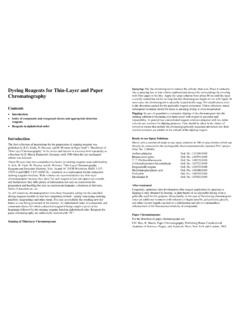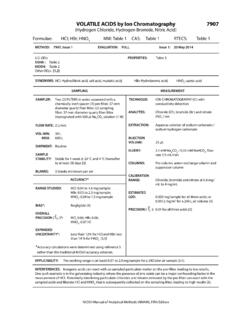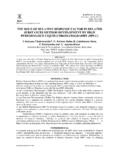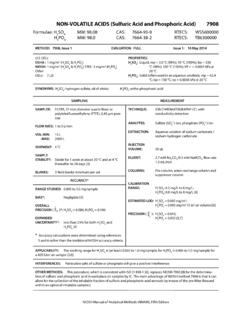Transcription of SULFUR DIOXIDE 6004
1 SULFUR DIOXIDESULFUR DIOXIDE 6004SO2 MW: CAS: 7446-09-5 RTECS: WS4550000 METHOD: 6004, Issue 2 EVALUATION: PARTIALI ssue 1: 15 May 1989 Issue 2: 15 August 1994 OSHA :5 ppmNIOSH: 2 ppm; STEL 5 ppm; Group I PesticideACGIH: 2 ppm; STEL 5 ppm(1 ppm = mg/m3 @ NTP)PROPERTIES:gas; vapor density (air = 1); BP -10 C; MP C;nonflammable SYNONYMS:noneSAMPLINGSAMPLER: FILTER + TREATED FILTER (cellulose + Na2CO3; preceded m cellulose ester membrane)FLOW to L/minVOL-MIN:4 L @ 5 ppm -MAX:200 LSHIPMENT:routineSAMPLE STABILITY:not determinedFIELD BLANKS:2 to 10 field blanks per setMEASUREMENTTECHNIQUE:ION CHROMATOGRAPHYANALYTE: sulfite and sulfate ionsEXTRACTION: 10 mL mM NaHCO3 mM Na2CO3 INJECTION LOOP VOLUME: 50 mM NaHCO3 mM Na2CO3,2 to 3 mL/minCOLUMNS: Ion Pac AS4A separator, Ion Pac AG4 Aguard.
2 Micromembrane suppressor [2]CONDUCTIVITY SETTING:10 S full scaleCALIBRATION: standard solutions of SO32 - and SO42 -in eluentRANGE: 11 to 200 g SO2 per sampleESTIMATED LOD: 3 g SO2 per sample [2]PRECISION (S r) [2]ACCURACYRANGE STUDIED:not studiedBIAS: not determinedOVERALL PRECISION (S rT):not determinedACCURACY:not determinedAPPLICABILITY: The working range is to 8 ppm ( to 20 mg/m3) for a 100-L air sample. The method is applicable to STEL samples. SO2 is collected on the back (treated) filter. Sulfuric acid, sulfate salts, and sulfite salts are collected on the front filterand may be quantitated as total particulate : SULFUR trioxide gas, if present in dry atmospheres, may give a positive interference for METHODS: This revises P&CAM 268 [3].
3 P&CAM 146 [4], P&CAM 163 [5], and S308 [6] use N H2O2 for sampling,followed by titration with NaOH or barium perchlorate. P&CAM 160 [7] uses tetrachloromercurate solution and visiblespectrophotometry. P&CAM 204 [8] uses a solid sorbent (molecular sieve 5A), thermal desorption, and mass Manual of Analytical Methods (NMAM), Fourth Edition, 8/15/94 SULFUR DIOXIDE : METHOD 6004, Issue 2, dated 15 August 1994 - Page 2 of 4 , deionized, filtered, specific conductance 10 solution. Dissolve 25 g Na2CO3 in deionized water. Add 20 mL glycerol anddilute with deionized water to 1 : mM NaHCO3 mM g NaHCO3 g Na2CO3 in 4 L filtereddeionized stock solutions , 1 mg/mL (as the anion). Preparein : dissolve gNa2SO3 in water.
4 Add 2 mL to 100 mL. Prepare fresh : dissolve g Na2SO4 in deionized water. Dilute to100 mL. Stable several weeks.*See SPECIAL : : two 37-mm diameter cassette filterholders (connected in series by a M-M Lueradapter, , Millipore XX1102503, or a shortpiece of plastic tubing) containing:a.(Front cassette) cellulose ester membranefilter, m pore size, supported by abackup (Back cassette) cellulose filter (Whatman40 or equivalent) which has beensaturated with fixative solution and dried20 to 30 min at 100 C, supported by aporous plastic support pad. sampling pump, to L/min,with flexible connecting tubing. , glass, 20-mL, screw-cap, such asscintillation vials.
5 ** chromatograph, HPIC-AS4A anionseparator and HPIC-AG4A guard, anionmicromembrane suppressor, conductivitydetector, and strip chart recorder. (Optional:integrator.) , 10-mL, polyethylene, with luer tip.** , in-line, luer-tip holder with membranefilter, 13- or 25-mm, m pore size. , 50- to 1000- L, with disposable tips.** flasks, 50- and 100-mL.** , 10-mL.** bottles, 250-mL.**Clean by rinsing thoroughly with PRECAUTIONS: each personal sampling pump with a representative sampler in end caps of sampler immediately before sampling. Attach sampler to personal sampling pump with flexible at an accurately known flow rate between and L/min for a total sample sizeof 40 to 200 L.
6 Do not exceed a total particulate loading of 2 mg on the front the sampler and pack securely for :If determination of sulfuric acid is required, transfer the front (membrane) filter to a clean vialwithin 4 h to avoid low recovery of sulfate. Handle the filter with tweezers to PREPARATION: the two filters from the sampler into separate, clean vials. Discard the backup pads. Add eluent to each vial and let stand, with occasional vigorous shaking, for 30 Manual of Analytical Methods (NMAM), Fourth Edition, 8/15/94 SULFUR DIOXIDE : METHOD 6004, Issue 2, dated 15 August 1994 - Page 3 of 4 NOTE:The SO2 collected on the treated (back) filter is present as sulfite, which oxidizes in airslowly (over several weeks) to sulfate.
7 The contributions of sulfite and sulfate found on theback filter must be summed, with appropriate stoichiometric factors applied, to give the SO2concentration (step 11). each sample into a syringe fitted with an in-line AND QUALITY CONTROL: daily with at least six working known aliquots of sulfate calibration stock solution to eluent in 50-mL volumetric flasks and dilute to the mark to produce solutions containing 1 to 20 g/mL SO42 sulfite standards in the same manner over the same working standards in tightly-capped polyethylene bottles. Prepare fresh working standards working standards with samples and blanks (steps 8 through 10).Prepare a calibration graph for each anion [peak height (mm or S) vs.]
8 G sulfite or sulfate].MEASUREMENT: ion chromatograph to conditions given on page 6004-1, according to manufacturer's instructions. sample aliquot. For manual operation, inject 2 mL of sample from syringe to ensure completerinse of sample :All samples, eluents, and water flowing through the ion chromatograph must be filtered toavoid plugging system valves or peak heights of sulfite and sulfate :If peak height exceeds linear calibration range, dilute with eluent, reanalyze, and apply theappropriate dilution factor in the mass, g, of sulfate equivalent found on the front (Wf) and back (Wb) filters and in thecorresponding average media blanks (Bf and Bb).NOTE:The sulfate equivalent is the sum of the sulfate peak, g, and times the sulfite peak, g, on the chromatogram ( = MW SO42 -/MW SO32 -): gsulfate equivalent = gsulfate + the concentration, CSO2, of SULFUR DIOXIDE , applying the factor (MW SO2/MW SO42 -) the concentration, CSO4, of particulate sulfate (including sulfuric acid) in the air volumesampled, V (L):NIOSH Manual of Analytical Methods (NMAM), Fourth Edition, 8/15/94 SULFUR DIOXIDE : METHOD 6004, Issue 2, dated 15 August 1994 - Page 4 of 4 EVALUATION OF METHOD:The sampler was adapted from that of Pate, et al.
9 [9]. In experiments in which SO2 was generated bypermeation tube and collected in impingers containing H2O2, untreated m cellulose ester membranefilters were shown to allow complete passage of SO2 [10]. In subsequent sampling of an atmospherecontaining ca. 10 ppm SO2 at 1 L/min for 30 min, two treated filters were placed in series following acellulose ester membrane filter. Recoveries were: mg SO2 from the first treated filter, mgSO2 from the second treated filter, and less than mg SO2 in the backup impinger containing NH2O2 [11]. Cellulose ester filters spiked with mg H2SO4 gave the following recoveries: usingH2O extraction, using hot H2O extraction, and using M HCl for study on filter impregnating solutions compared NaHCO3 and KOH.
10 The chromatograms of samplesfrom the KOH-treated filters had noticeably flattened and broadened peak shapes as well as retentiontimes reduced by approximately 10% when compared to the chromatograms of H2SO4 spiked on filtersimpregnated with NaHCO3[1].REFERENCES: [1]Williamson, NIOSH/MRSB Sequence 7452-B (unpublished, July 6, 1992). [2]Williamson, NIOSH/MRSB Sequence 7452-C (unpublished, July 22, 1992). [3]NIOSH Manual of Analytical Methods, 2nd ed., Vol. 5, P&CAM 268, Department of Health andHuman Services, Publ. (NIOSH) 79-141 (1979). [4]Ibid., 2nd ed., Vol. 1, P&CAM 146, Publ. (NIOSH) 77-157-A (1977). [5]Ibid., 2nd ed., Vol. 1, P&CAM 163, Publ. (NIOSH) 77-157-A (1977). [6]Ibid., 2nd ed., Vol. 4, S308, Publ. (NIOSH) 78-175 (1978).














